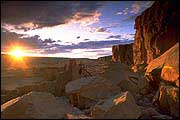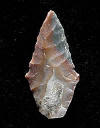
|
PREHISTORIC CULTURES OF NORTH AMERICA |
| S. Crouthamel, American Indian Studies/Anthropology, Palomar College |
ASSIGNMENTS
Test 1 & Test 2: Two tests will be give over the term with Test #1 covering the first half through Far Western Traditions (I-VI) and Test #2 will cover the second half through Contemporary Issues (VII-IX). There will not be a comprehensive final exam in this course. See Course Contents: Semester Schedule/ Due Dates for the tests. The tests themselves will be a combination of fill in, short answer, and essay.

Data Interpretation Practicum: This will be an exercise in identification of artifacts and non-artifacts. An object can be one of the following:
I. NATUREFACT: an object that has been formed by natural
forces.
|
||
| II. ARTIFACT: an object that has been modified by humans (A) |
The difficulty is that objects are formed by complex processes such that a Biofact, such as an animal bone can be preserved after the animals death and be permineralized
or fossilized to result in a Geofact. Humans in turn can modify a variety of objects, Geofacts, Biofacts,
or fossils. Humans can produce synthetic material such as plastic which
could be considered fundamentally a Biofact/Geofact (fossil fuel). The difficulty is
demonstrating that humans modified an object, especially garbage or
discarded waste
that was never modified as a specific tool. This is usually
referred to as middens and the material was modified by humans. This is one of the
reasons that scientific excavation provides much more information than
non systematic digging or pot hunting. However, differentiating human modified
objects like fire
affected rock (F.A.R.) vs. natural brush fire affected rock is not easy.
Furthermore, herds of large animals can bang around river cobbles enough
where the resultant chipped stone may appear to be rudimentary tools that most
early hunters and gathers produced. Most of the objects in the practicum will
be rather easy to differentiate. On each of the numbered (20) objects you have
two lines to fill out. On line a) you want to put the appropriate combination of
G-B-A depending on the sequence of how the object was modified.
For instance if you have a stone tool that a human has
shaped by flint knapping made into a projectile point , you would designate it as a
G-A. The
production of an artifact must come from a 'Geofact' or 'Biofact'.
A piece of animal bone
, you would designate it as a
G-A. The
production of an artifact must come from a 'Geofact' or 'Biofact'.
A piece of animal bone  modified by humans would be a B-A.
If a human took a fossil B-G and made it into an artifact you would put
B-G-A.
modified by humans would be a B-A.
If a human took a fossil B-G and made it into an artifact you would put
B-G-A.
If an object is an artifact you need to fill out line b) with the culture area of North America, such as Southwest (SW) and the tradition it is from, such as Mogollon. You are not required to give any more specifics like exact use or date. These require more careful analysis. Even projectile points are often merely classed as a bifacial since the object may have been used as a cutting tool rather than a projectile point. If the object is not an artifact you do not need to fill out line b). During the semester try the practice practicum examples that are set up as a discussion. There is a photo gallery on the Main Page that may help determine culture area and tradition of these objects.
Paper/Archaeological Site Assessment: This is a 7-10 page paper in which you will choose an archaeological site and write a research paper to assess the site. Here is the suggested outline of points relative to the site you choose.
| I. History | Summarize the history of this particular site's activities, to include archaeological excavation, pot hunting and even purposeful/accidental destruction |
| II. Cultural Significance | Identify the cultural area first, then determine what has been learned about cultural traditions at this site; some sites will have a long sequence of human occupation; some may represent one tradition. |
| III. Contemporary Status | Discuss the status of this site today; is it well preserved, threatened or destroyed? Is current research being conducted? Is this site under international, federal or local protection. |
If you are currently in other archaeological programs or doing contract work, note that this paper is not an EIR type of site report and should not list data, artifacts, etc. You can report on a site you are working on or one that is local but use the outline above. Also, you may choose any site in the Americas. Some of the links and the text will help you identify sites, however you must have sources outside of just internet/urls. The paper is to be double-spaced and have a reference page at the end. If you are used to citation in the text, you may use what you prefer, but it is not required. You may also include a few maps or pictures. Feel free to e-mail for any help or just to run a site by me. You do not want to do an entire area, like Chaco Canyon, pick one of 40 sites that are in the canyon. Sites can also have weird names (i.e. Montezuma's Castle) that have nothing to do with the culture they represent.